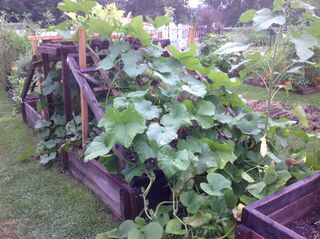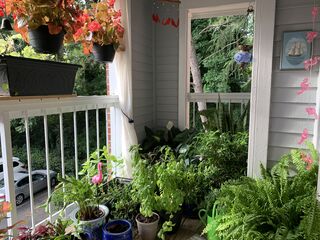Resilience
How Plants and Flowers Support Hope and Resilience
Personal Perspective: As reminders of vitality, green things help keep us going.
Posted August 12, 2022 Reviewed by Ekua Hagan
The balcony is one of the main reasons I rented my new apartment here in Atlanta. I knew I would transform it into my own private garden oasis. I pictured the vines and greenery and the feelings they would evoke in me—feelings of joy, pleasure, and satisfaction at seeing my labors rewarded with happy green growing things.
I’ve had a green thumb since I was a boy. I had my first flower garden when I was 5 years old. How I cried the time Mom accidentally ignited a fire in the woods bordering our yard. “My flowers!” I wailed.
Mom and I shared our love of plants and flowers from way back then. It was a subject we both enjoyed talking about. Having her to talk with about it is one of the things I dearly miss since Mom’s death nearly three years ago.
Throughout the hospitalizations and stints in rehab that followed and filled far too many weeks of her last few years, I always made sure there were flowers and plants in her room. During what I call “Mom’s seven-month ordeal” that lasted from late summer until the following spring, I marked the passage of time and the seasons by the particular flowers in her room: from the chrysanthemums of autumn to Christmas poinsettias, to daffodils, and later her favorite, lilacs, in the spring.
It wasn’t only our shared love of plants and flowers that inspired me to bring them to Mom during her medical difficulties. I considered them an important part of her recuperation because, in my experience, plants and flowers—so vibrant with beauty and life force—represent hope and health.
That’s exactly why I treasured the big vegetable and flower garden I tended for eight of the years I lived back in my hometown in Connecticut before moving to Atlanta in the spring of 2021. It helped me stay connected to feelings of hope and the possibility of a fresh start as each new plant started out so small and fragile before growing into the vines and stalks that would eventually produce the beautiful food I loved to cook, eat, and share, and the cut flowers I would put in vases throughout the house.
That garden got me through some mighty difficult years as I figured out how exactly to live well with a serious chronic illness and struggled to stay plugged into my big-city career as a freelance writer and piece together even a modest income. I’ve never felt lonelier than I did in those years, far from my city friends and far from the few local friends I made, too, in terms of how little we shared in common and I felt listened to.

“Farmer John”—as Mom nicknamed me, and I wore proudly—found a sense of meaning and purpose in his garden. Its lushness and fecundity filled me with a sense of overflowing abundant life. That helped me stay mindful of life’s goodness, kept me feeling grateful for all I did have and helped nurture my growth mindset when things too often didn’t feel so good—especially when Mom wasn’t well and I was sad and worried about what losing her would mean, an impending moment in my life I had always dreaded.
A friend once commented on how “useless” he found petunias because, he said, they didn’t produce fruit or do anything worthwhile. I responded that their beauty alone was the point. They needn't do more than be beautiful to justify their existence. Simply being beautiful is all they need to exist for or do.

And being able to find joy in that beauty, and inspiration in the exuberance that flowers display, are traits to cultivate in yourself.
That’s exactly what my balcony is for me today. It has indeed become my private oasis with the variety of plants I have out there, including four hanging begonias, a big Boston fern, a peace lily, a snake plant, gardenia, rosemary, basil, and even Cala lily. It calms my heart just to look at it. It satisfies my desire to witness the positive outcomes of my work. And it keeps me mindful of the importance of beauty and reminds me that life renews itself and next chapters—like new growth and new seasons—are always possible as long as we are alive.


